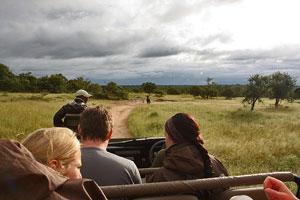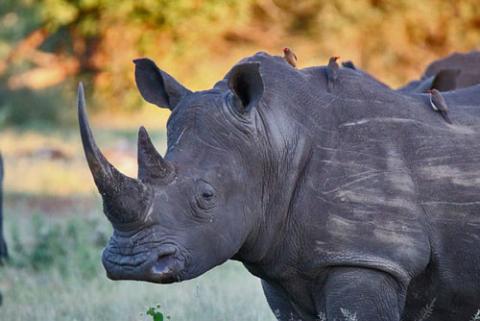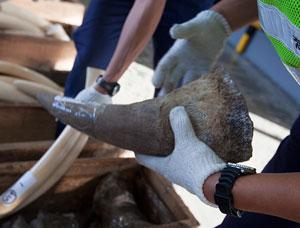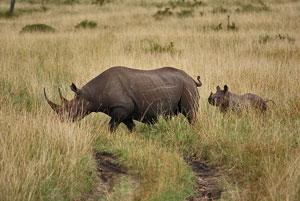When we think about the safest places for wild animals, areas such as national parks tend to come to mind. Efforts to bring the rhino back from the brink of extinction have succeeded in South Africa, notably in Kruger National Park, but now officials are moving some rhino out of the park to other locations where it's hoped they would be safer from poachers.
The decline in rhino numbers over the past century has been staggering. At the beginning of the 20th century there were an estimated 500,000 rhinos across Africa and Asia; today about five percent of that number (29,000) remain worldwide, most of them in South Africa.
One of the great wildlife success stories is in South Africa's Kruger National Park, where wild rhinos were locally extinct in 1900. About 50 years ago, 351 rhino were relocated to the park from a game reserve in KwaZulu-Natal, and today, about 9,000 white rhino and perhaps 300 of the critically endangered black rhino live in the park.
Rise in Poaching Threatens to Reverse Recent Gains in Rhino Population
Those are impressive gains, but growth in rhino populations has leveled off, and that has wildlife officials concerned. The reason: an explosion in poaching activity. A report from the International Rhino Foundation notes, "Overall, populations have remained relatively stable in the face of increasingly aggressive and sophisticated poaching, but the situation is almost certainly unsustainable over the long-term."
Is the problem really that serious? Recent statistics say it is, and the situation is growing worse.
In 2007, 13 were rhino were illegally killed in South Africa; in 2013 those known losses jumped to 1,004 animals. Already this year, 630 rhinos are known to have been poached in South Africa'and 408 of them were from Kruger National Park.
Why is the problem so severe in one of Africa's iconic wildlife parks?

Wildlife viewing is the primary attraction at Kruger National Park. Photo by Joost Rooijmans via Creative Commons and Flickr.
Kruger National Park was established in 1898 and is one of the premiere destinations for visitors seeking a wildlife viewing experience in a natural area. The park's large size'at 4.85 million acres it's over twice the size of Yellowstone'has provided a haven for not only rhinos, but also for elephants, lions, leopards, buffalo, and over 140 other species of mammals.
Large Size and Remote Terrain of Kruger National Park Makes Protection of Wildlife a Challenge
The large size of the park, combined with the rugged terrain and the relatively large concentration of wildlife, is ironically proving to be detrimental to efforts to protect these animals from an onslaught of poachers. There simply aren't enough resources to patrol all areas of the vast reserve, and poachers are increasingly heavily financed...and well-equipped with technology such as helicopters and night vision equipment.
Crawford Allan, Senior Director, TRAFFIC (the wildlife trade monitoring network)/WWF (World Wildlife Fund) offered this analysis of the problem:
'The insatiable demand and mind-boggling prices for rhino horn means that rhinos are no longer safe anywhere ' even in highly protected areas like South Africa's Kruger National Park. Since 2010, the park has become like a war zone, with military deployed to intercept poachers in an attempt to prevent the massive increases in rhino killing year on year."
Organized Crime Moves into the Illegal Wildlife Trade
"The trafficking in rhino horn is now a sophisticated organized crime operation, that connects Africa to the demand markets in Asia. In Vietnam, consuming or gifting rhino horn to prevent cancer, hangovers or sexual dysfunction is the ultimate status symbol for the upper echelons of society," Allan said. "To many buyers it does not matter if it really works, it is the social standing it brings that is everything.'
Wildlife officials across southern Africa are concerned, and on August 12, the Republic of South Africa Department of Environmental Affairs announced a new plan for "integrated strategic management of rhinoceros in South Africa." That comprehensive effort includes relocation of some of the animals out of that nation's flagship wildlife attraction.
"It is clear from regular surveys that rhinos are found in different densities across Kruger National Park," a Department statement noted. "Poaching pressure is also uneven across the Park's landscape. Some areas are relatively free of recorded poaching incidents while others are hard hit by poachers."
"We recognise that poaching is part of a multi-billion dollar worldwide illicit wildlife trade. Addressing the scourge is not simple. That is why we will continue to strengthen holistic and integrated interventions and explore new innovative options to ensure the long-term survival of the species."
Relocation of Some Rhinos to Safer Areas is Underway
Among those options will be "translocation" (in the U.S. we'd call it "relocation") of some of the animals from the national park to other areas where the combination of better protection and favorable habitat will provide "rhino strongholds."
According to a Department spokesperson, "South Africa is considering a range of rhino strongholds inclusive of South African national parks, provincial reserves, communal areas and private reserves. South Africa also recognizes international opportunities for establishing rhino strongholds in neighbouring countries in Southern Africa."
South Africa National Parks large mammal ecologist Sam Ferreira said up to 500 rhino could be removed from the park under this program. "If you want to give rhino a chance, you remove them from places where they have a high probability of being killed," Ferreira said.
Several non-government organizations such as the World Wildlife Fund are cooperating in the latest translocation effort, and in similar projects elsewhere in the country, such as the Black Rhino Range Expansion Project. The video below offers a quick look at how helicopters are being used to move animals from remote areas.
The video showing the animal hanging upside down from its ankles may raise questions from some viewers, but as WWF's Project Leader Dr. Jacques Flamandit explains, it actually has a number of advantages for the animals.
"Previously rhinos were either transported by lorry over very difficult tracks, or airlifted in a net. This new procedure is gentler on the darted rhino because it shortens the time it has to be kept asleep with drugs, the respiration is not as compromised as it can be in a net and it avoids the need for travel in a crate over terrible tracks,' says Dr Flamand.
'Another advantage is that rhinos can be more easily removed from dangerous situations, for example if they have fallen asleep in a donga or other difficult terrain after being darted. The helicopter translocations usually take less than ten minutes, and the animals suffer no ill effect. All of the veterinarians working on the translocation agreed that this was now the method of choice for the well-being of the animals.'
Moving Rhinos to Less Populated Areas Speeds Reproduction
Dr. Joseph Okori, a veterinarian and head of WWF's African rhino team, explained the strategy.
"When rhinos in one area reach a critical number, which we call the maximum carrying capacity, they start to get aggressive - fighting with one another because of lack of space. Instead of seeing an increase they start to decline. When you put them in new areas the new population is then able to breed."
"We move them in groups of 20 because we have found that is the minimum number for successful breeding. And the best ratio is about ¾ female and the other ¼ being male. If there are too many males in one area, we move some to maintain a stable breeding balance," Okori said.
These and other efforts are seen as critical to long-term survival of the species. South Africa is now home to about 93% of Africa's white rhino and 39% of Africa's black rhino; spreading the animals over a wider area and into more secure locations seems to be a good strategy.






Comments
Saw a bumper sticker recently that said "The dried testicles of rhino poachers cures aids"..
The sad thing is some people will believe it.
I heard that the dried rhino horn instills courage. That is why it was harvested. It supposedly helped people face their fears and overcome cowardice. Kind of like a cure for yellow bellied cowards. Apparently Africans have a few men in tribes who were, like in Native American times, relegated to skirt duty with the women while the men went off to hunt and participate in manly activities and fight.
Ahh how cute, Mr Mackey. Did these men also live alone down in a van by the river?
On a more serious note about a major wildlife problem, as the story points out rhinos are at risk due to the combination of superstition, ignorance and status-seeking concerning the use of rhino horn. Add to that mix greed and illegal trafficing of wildlife products by organized crime, and you have a serious challenge for protection of this species.